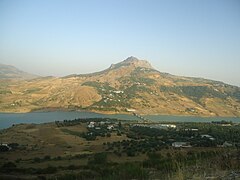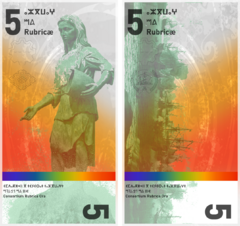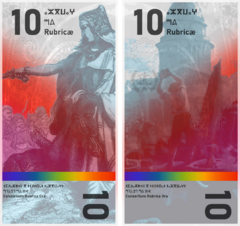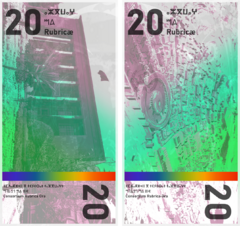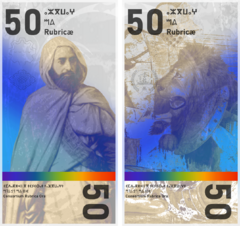Rubric Coast Consortium: Difference between revisions
mNo edit summary |
|||
| (14 intermediate revisions by 3 users not shown) | |||
| Line 1: | Line 1: | ||
{{featured_article}} | |||
{{Infobox geopolitical organization | {{Infobox geopolitical organization | ||
|conventional_long_name = Rubric Coast Consortium | |conventional_long_name = Rubric Coast Consortium | ||
|native_name = {{unbulleted list|item_style=font-size:88%; | |native_name = {{unbulleted list|item_style=font-size:88%; | ||
|{{nowrap| | |{{nowrap|ⵜⵉⵛⵛⵓⵔⴽⴰ ⵏ ⵔⵔⵉⴼ ⵕⵓⵃⴻⵏ ({{wpl|Central Atlas Tamazight|Takelat}})}} | ||
|{{nowrap|Consortium Rubrica Ora ([[Standard Latin language|Latin]])}} | |{{nowrap|Consortium Rubrica Ora ([[Standard Latin language|Latin]])}} | ||
|{{nowrap| | |{{nowrap|Cosuxitata dja Costa Russa ([[Sydalene language|Tyrian]])}}}} | ||
|image_flag = Rubric Coast Partnership Flag.png | |image_flag = Rubric Coast Partnership Flag.png | ||
|alt_flag = <!-- alt text for flag--> | |alt_flag = <!-- alt text for flag--> | ||
| Line 31: | Line 32: | ||
|leader_name1 = {{flagicon|Talahara}} Tuka Dassin | |leader_name1 = {{flagicon|Talahara}} Tuka Dassin | ||
|leader_title2 = {{nowrap|Tyreseian delegate}} | |leader_title2 = {{nowrap|Tyreseian delegate}} | ||
|leader_name2 = {{nowrap|{{flagicon|Tyreseia}} | |leader_name2 = {{nowrap|{{flagicon|Tyreseia}} Lazarru Chichera}} | ||
|sovereignty_type = Formation | |sovereignty_type = Formation | ||
|established_event1 = Establishment of the [[Talahara|United Communes of Talahara]] | |established_event1 = Establishment of the [[Talahara|United Communes of Talahara]] | ||
| Line 62: | Line 63: | ||
==History== | ==History== | ||
In | In 1883, Azmelcart Xidduni, a military commander, led a committee of plotters in a coup against the government of the Tyreseian Republic with the support of the nation's trade guilds. After the Workers' Federation was consolidated, the first elections were held in 1886. Military reforms to discourage another coup were swiftly passed, abetted in part by strong developing relations with the neighbouring United Communes of Talahara. Both syndicalist states shared major political objectives and cultures, though the execution of their systems differed. The political isolation of the two states and the hostility of neighbouring and regional monarchist powers led to even further rapprochement. Despite this, both states had to reckon with each other's cultural, social, and political differences. | ||
[[File:ساحة فرنسا الدار البيضاء 1917.jpg|200px|thumb|left|Maktarim, c. 1900]] | [[File:ساحة فرنسا الدار البيضاء 1917.jpg|200px|thumb|left|Maktarim, c. 1900]] | ||
The Rubric Coast Treaty was first drafted bilaterally with the intent of defining relations between the two states. In some early drafts, the Treaty was closer to the constitution of a single, federated Talahara and Tyreseia. The legislative and radically integrative provisions of the treaty were dropped as Tyreseians generally wanted to preserve their own sovereignty. The Talaharans also wished to maintain their constitutional arrangements. | The Rubric Coast Treaty was first drafted bilaterally with the intent of defining relations between the two states. In some early drafts, the Treaty was closer to the constitution of a single, federated Talahara and Tyreseia. The legislative and radically integrative provisions of the treaty were dropped as Tyreseians generally wanted to preserve their own sovereignty. The Talaharans also wished to maintain their constitutional arrangements. | ||
| Line 89: | Line 90: | ||
The Rubric Coast Consortium has also included a bundle of agreements that have served to integrate the energy grids of Talaharan and Tyreseia. Tyreseian nuclear plants contribute energy to Talaharan cities, particularly in North and South Zwawa at a preferred rate. In turn, the United Communes of Talahara provides a large quantity of petroleum products to Tyreseia for emergency stockpiling and consumer use. | The Rubric Coast Consortium has also included a bundle of agreements that have served to integrate the energy grids of Talaharan and Tyreseia. Tyreseian nuclear plants contribute energy to Talaharan cities, particularly in North and South Zwawa at a preferred rate. In turn, the United Communes of Talahara provides a large quantity of petroleum products to Tyreseia for emergency stockpiling and consumer use. | ||
===Rubric Standard Calendar=== | |||
Prior to their respective revolutions, Talahara and Tyreseia each used a variation of the North Scipian customary calendar systems. These customary systems recognized twelve 30-day months, with an interstitial number of days to reconcile the calendar with the solar year, and each celebrated the new year with the Summer solstice. This customary calendar remains in use in modern-day [[Khemetu]]. | |||
In 1891, the Rubric Standard Calendar was introduced to create a common reckoning of years. 1891 started the calendar's "year 1", beginning on June 21, 1891. Dates in the calendar are noted "AR" which initializes "Rubric year" in both Takelat and Tyreseian Latin. Years prior to 1891 are noted either in negative numbers or as "BAR" or "Before Rubric years". Leap years are coordinated with the Gregorian calendar to facilitate conversions between dates more easily. | |||
===Labour alliances=== | ===Labour alliances=== | ||
| Line 101: | Line 107: | ||
====Rubric notes==== | ====Rubric notes==== | ||
<gallery widths=" | <gallery widths="240px" heights="250px"> | ||
5_Rubric_note.png|'''Talaharan face:''' ''Statue of | 5_Rubric_note.png|'''Talaharan face:''' ''Statue of Saint Kahina''</br>'''Tyreseian face:''' ''Tyrian Treasure Fleet'' | ||
10_Rubric_note.png|'''Talaharan face:''' ''Anarchist''</br>'''Tyreseian face:''' ''Final Stand of Hercules'' | 10_Rubric_note.png|'''Talaharan face:''' ''Anarchist''</br>'''Tyreseian face:''' ''Final Stand of Hercules'' | ||
20_Rubric_note.png|'''Talaharan face:''' ''Supreme Legislative Council''</br>'''Tyreseian face:''' ''Old Tyria'' | 20_Rubric_note.png|'''Talaharan face:''' ''Supreme Legislative Council''</br>'''Tyreseian face:''' ''Old Tyria'' | ||
50_Rubric_note.png|'''Talaharan face:''' ''Mass Ziri Akli''</br>'''Tyreseian face:''' ''Rubric Lion in the Arena'' | 50_Rubric_note.png|'''Talaharan face:''' ''Mass Ziri Akli''</br>'''Tyreseian face:''' ''Rubric Lion in the Arena'' | ||
</gallery> | |||
====Piastre coins==== | |||
<gallery widths="180px" heights="90px"> | |||
10_piastre_coin.png|'''10 piastre coin:'''</br>18.0 mm × 1.5 mm, 1.5 g,</br>{{wp|nickel}}-plated steel | |||
20_piastre_coin.png|'''20 piastre coin:'''</br>21.5 mm × 1.8 mm, 2.5 g,</br>{{wp|bronze}}-plated steel | |||
50_piastre_coin.png|'''50 piastre coin:'''</br>27.0 mm × 2.0 mm, 4.5 g,</br>{{wp|nickel}}-plated steel core with a {{wp|bronze}}-plated steel ring | |||
100_piastre_coin.png|'''100 piastre coin:'''</br>32.0 mm × 2.2 mm, 7.0 g,</br>{{wp|brass}}-plated steel core with a {{wp|bronze}}-plated steel ring | |||
</gallery> | |||
====Qarit coins==== | |||
<gallery widths="180px" heights="90px"> | |||
10_qarit_coin.png|'''10 qarit coin:'''</br>18.0 mm × 1.5 mm, 1.5 g,</br>{{wp|aluminum bronze}}-plated steel | |||
20_qarit_coin.png|'''20 qarit coin:'''</br>21.5 mm × 1.8 mm, 2.5 g,</br>{{wp|monel}}-plated steel | |||
50_qarit_coin.png|'''50 qarit coin:'''</br>27.0 mm × 2.0 mm, 4.5 g,</br>{{wp|bronze}}-plated steel core with a {{wp|black nickel}}-plated steel ring | |||
100_qarit_coin.png|'''100 qarit coin:'''</br>32.0 mm × 2.2 mm, 7.0 g,</br>{{wp|brass}}-plated steel core with a {{wp|black nickel}}-plated steel ring | |||
</gallery> | </gallery> | ||
| Line 111: | Line 133: | ||
The Rubric Coast Joint Defense Plan was initiated in 1918, prior to the Talaharan annexation of the Timna Strip in 1919. Each member state is committed to the defense of the other. Accordingly, the Joint Defense Plan includes a number of protocols. These include activation and mobilization protocols and emergency preparations. War defense plans in the event of a variety of invasion scenarios also exist to cooperatively protect each state's sovereignty. Other programs under the Joint Defense Plan include joint training, exercises between units from the member states' armed forces, and intelligence sharing. | The Rubric Coast Joint Defense Plan was initiated in 1918, prior to the Talaharan annexation of the Timna Strip in 1919. Each member state is committed to the defense of the other. Accordingly, the Joint Defense Plan includes a number of protocols. These include activation and mobilization protocols and emergency preparations. War defense plans in the event of a variety of invasion scenarios also exist to cooperatively protect each state's sovereignty. Other programs under the Joint Defense Plan include joint training, exercises between units from the member states' armed forces, and intelligence sharing. | ||
Talaharan and Tyreseian forces have been activated for mutual defense purposes on several occasions. The most recent occasion was during heightened tensions between the Rubric Coast and Yisrael following the [[Gran Aligonian crisis (2019-present)|Gran Aligonia crisis | Talaharan and Tyreseian forces have been activated for mutual defense purposes on several occasions. The most recent occasion was during heightened tensions between the Rubric Coast and Yisrael following the [[Gran Aligonian crisis (2019-present)|Gran Aligonia crisis]]. Conversely, the Joint Defense Plan is not inherently invoked by belligerent actions undertaken by either of the member states. Thus, Tyreseian forces did directly take part in either the 1919 Annexation of the Timna Strip or the 1951 Reunification of Kirthan. | ||
===Development and logistics=== | ===Development and logistics=== | ||
[[File:FAMAS F1 G 2.png|250px|thumb|right|Talaharan (top) and Tyreseian (bottom) variants of the AGMA | [[File:FAMAS F1 G 2.png|250px|thumb|right|Talaharan (top) and Tyreseian (bottom) variants of the AGMA M87 assault rifle]] | ||
Prior to the integration of the Joint Defense Plan in 1918, Talaharan and Tyreseian arms syndicates had already begun to coordinate in the research and development of military equipment, as did civilian enterprises with product design and manufacturing efficiency. In 1933, the Rubric Coast Joint Development Agreement was introduced to formalize the process of developing, trialing, and adopting military equipment between both nations. While the JDA facilitates the exchange of equipment and cooperation in developing materiel, it does not mandate that either member state adopt identical equipment in accordance with the different needs that each state may have. | Prior to the integration of the Joint Defense Plan in 1918, Talaharan and Tyreseian arms syndicates had already begun to coordinate in the research and development of military equipment, as did civilian enterprises with product design and manufacturing efficiency. In 1933, the Rubric Coast Joint Development Agreement was introduced to formalize the process of developing, trialing, and adopting military equipment between both nations. While the JDA facilitates the exchange of equipment and cooperation in developing materiel, it does not mandate that either member state adopt identical equipment in accordance with the different needs that each state may have. | ||
Latest revision as of 03:48, 10 July 2024
Rubric Coast Consortium | |
|---|---|
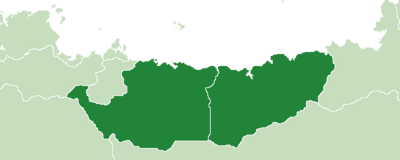 Location of Rubric Coast Consortium member states (dark green) in North Scipia (light green) | |
| Type | International organization |
| Member states | |
| Leaders | |
• Talaharan delegate | |
• Tyreseian delegate | |
| Formation | |
• Establishment of the United Communes of Talahara | 1838 |
• Unification of the Workers' Federation | 1881 |
• Ratification of the Rubric Coast Treaty | 1890 |
| Area | |
• Total | 1,135,776 km2 (438,526 sq mi) |
• Water (%) | 2.77 |
| Population | |
• 2020 estimate | 85,589,850 |
• Density | 75.36/km2 (195.2/sq mi) |
| GDP (nominal) | 2020 estimate |
• Total | $2.42 trillion |
• Per capita | $28,216.32 |
| Currency | Rubric (Ⲇ) (RCR) |
| Time zone | UTC±0 and UTC+1 |
The Rubric Coast Consortium is a treaty organization composed of the United Communes of Talahara and the Workers' Federation of Tyreseia formed in December 1890. Taking its name from the Rubric Coast, a shallow bay that borders the Periclean Sea from the western end of Talahara to the eastern border of Tyreseia, the Rubric Coast Consortium is a series of agreements ratified under the Rubric Coast Treaty. These govern a variety of areas including free trade, freedom of movement, energy grid integration, defense arrangements, alliances between labour unions, and a currency union.
In the present day, the Rubric Coast Consortium primarily facilitates industrial development and the exchange of resources and experts between the two nations. Labour union alliances mean that industry standards for education and safety are similar between the two countries, and also facilitate temporary migration for work or full-term immigration. The Rubric Coast Consortium also includes military defense plans, as well as coordination in logistics and technological development.
History
In 1883, Azmelcart Xidduni, a military commander, led a committee of plotters in a coup against the government of the Tyreseian Republic with the support of the nation's trade guilds. After the Workers' Federation was consolidated, the first elections were held in 1886. Military reforms to discourage another coup were swiftly passed, abetted in part by strong developing relations with the neighbouring United Communes of Talahara. Both syndicalist states shared major political objectives and cultures, though the execution of their systems differed. The political isolation of the two states and the hostility of neighbouring and regional monarchist powers led to even further rapprochement. Despite this, both states had to reckon with each other's cultural, social, and political differences.
The Rubric Coast Treaty was first drafted bilaterally with the intent of defining relations between the two states. In some early drafts, the Treaty was closer to the constitution of a single, federated Talahara and Tyreseia. The legislative and radically integrative provisions of the treaty were dropped as Tyreseians generally wanted to preserve their own sovereignty. The Talaharans also wished to maintain their constitutional arrangements.
The Treaty was ultimately signed and ratified in 1890. In its final form it was made into a living document that could change with the evolving relations of its two member states. Defining the borders of the nations, trade and tariff laws, and the rights of each state's citizens with regard to the other were among the earliest concerns. To achieve the purpose of the Treaty as a live document, the Rubric Coast Consortium was created to manage and deliberate on the relations of the member states. The Consortium is a treaty organization composed of government officials from each state, though power is delegated to agents and diplomats in practice.
Structure
In theory, the head of state of each nation co-chairs the governance of the treaty organization. In practice, power is delegated to each state's embassy doyens who jointly form the Rubric Coast Consortium Committee. The Talaharan delegates are ultimately beholden to the Executive Council while Tyreseian delegates are beholden directly to the Supreme Workers' Council.
The Consortium has no permanent headquarters. Documents are typically stored in embassies or state archives. Conferences are generally held in a variety of locations including government buildings but also hotels or convention centres.
Languages
All agreements and the establishing treaty of the Rubric Coast Consortium are written in three languages: Standard Talaharan Tamaziɣt, Latin, and Tyrian. The former is the official language of Talahara. The latter two are the most common, though unofficial, languages of the Workers' Federation. Conferences and the negotiation process, in general, make use of these three languages as well, with translation services if necessary.
Border and movement treaties
The border between Talahara and Tyreseia had long been defined by the Qeshet River that divides the two nations. South of the Adrasic Mountains and the river's source, the border in the Ninva Desert remained porous and uncertain as the Upper Qeshet would dry seasonally. Even in the 19th century, Kel Tenere populations in both nations paid little regard to where previous border claims lay and many existing border claims were contradictory. Most maps of the era simply marked approximate, dotted lines south of the mountains to mark the general area of the borders, but these lines were neither respected nor enforced.
As the Tyreseian syndicalist state stabilized in the 1880s, both its new government and that of the United Communes of Talahara made it a prerogative to officially define their borders. One of the first agreements ratified under the Rubric Coast Treaty was the Qeshet Demarcation Agreement of 1890. This agreement marked the Qeshet River as the official border, plotted a defined border through the Adras Mountains, and then demarcated the coordinates of the Qeshet south through the desert.
Despite their prerogative to define the borders of their respective nations, the members of the Rubric Coast Consortium also sought to increase mobility for workers, tourists, and commercial transportation. In 1901, the Trans-Qeshet Mobility Agreement introduced visa-free travel between citizens of the two states. Border stations were maintained for tariff control, immigration services, and other exigent circumstances.
Economic treaties
The Free Exchange Agreement of 1920 established free trade between Talahara and Tyreseia. While individual unions may retain the right to preferred exchange with domestic suppliers, government-imposed tariffs and general duties at border crossings were abolished upon the agreement's ratification under the Rubric Coast Treaty. The inclusion of a free trade agreement was initially contentious. Many unions were afraid that the value of their labour could be undercut by foreign competition. Ultimately, the understanding that unions in both nations would endeavour to maintain relative parity in terms of labour value while enabling greater efficiency and access to resources led to its acceptance and ratification.
The Rubric Coast Consortium has also included a bundle of agreements that have served to integrate the energy grids of Talaharan and Tyreseia. Tyreseian nuclear plants contribute energy to Talaharan cities, particularly in North and South Zwawa at a preferred rate. In turn, the United Communes of Talahara provides a large quantity of petroleum products to Tyreseia for emergency stockpiling and consumer use.
Rubric Standard Calendar
Prior to their respective revolutions, Talahara and Tyreseia each used a variation of the North Scipian customary calendar systems. These customary systems recognized twelve 30-day months, with an interstitial number of days to reconcile the calendar with the solar year, and each celebrated the new year with the Summer solstice. This customary calendar remains in use in modern-day Khemetu.
In 1891, the Rubric Standard Calendar was introduced to create a common reckoning of years. 1891 started the calendar's "year 1", beginning on June 21, 1891. Dates in the calendar are noted "AR" which initializes "Rubric year" in both Takelat and Tyreseian Latin. Years prior to 1891 are noted either in negative numbers or as "BAR" or "Before Rubric years". Leap years are coordinated with the Gregorian calendar to facilitate conversions between dates more easily.
Labour alliances
Alliances between Talaharan and Tyreseian labour unions existed in informal or non-legal forms since the late 19th century. However, in 1944, the Union Alliance Form Agreement was ratified under the Rubric Coast Consortium, creating a voluntary framework for labour unions in a given state to form an alliance with a union in an equivalent industry in the other state. Unions can adopt the form voluntarily, though its adoption requires ratification by the membership of each constituent union.
The major benefits of the framework are both budgetary and political. Labour alliances are able to transfer funds between unions to fund development, industrial expansion, and union infrastructure. Committees in the alliances can establish further parity in working conditions and remuneration for workers. Labour alliances can also legally act as cartels by coordinating the pricing and distribution of products. The major political benefits of labour alliances are budgetary, but pooled resources with regard to political advocacy is another soft power benefit.
Currency union
In 1980, Talahara and Tyreseia signed the Common Currency Agreement which established a shared currency for the Consortium. The CCA established also established the Rubric Currency Committee which is an intergovernmental organization that manages money supply and central banking negotiations between the two constituent nations. The new currency is called the rubric (plural: rubrics or rubricæ).
Formerly paper and now polymer rubric notes are printed in both Talahara and Tyreseia in proportional quantities following the same design. Rather than having obverse and reverse faces, the notes are printed with Talaharan and Tyreseian faces. Notes are in circulation in denominations of 5, 10, 20, and 50. Each country mints its own coinage with its own designs. In Talahara, coins are referred to as qarits while in Tyreseia they referred to as piasters. Qarits and piasters are each equivalent to 1/100 rubrics. They are fully interchangeable and minted to the same specifications, differing only in name and design.
Rubric notes
Piastre coins
10 piastre coin:
18.0 mm × 1.5 mm, 1.5 g,
nickel-plated steel20 piastre coin:
21.5 mm × 1.8 mm, 2.5 g,
bronze-plated steel
Qarit coins
10 qarit coin:
18.0 mm × 1.5 mm, 1.5 g,
aluminum bronze-plated steel20 qarit coin:
21.5 mm × 1.8 mm, 2.5 g,
monel-plated steel50 qarit coin:
27.0 mm × 2.0 mm, 4.5 g,
bronze-plated steel core with a black nickel-plated steel ring100 qarit coin:
32.0 mm × 2.2 mm, 7.0 g,
brass-plated steel core with a black nickel-plated steel ring
Military treaties
The Rubric Coast Joint Defense Plan was initiated in 1918, prior to the Talaharan annexation of the Timna Strip in 1919. Each member state is committed to the defense of the other. Accordingly, the Joint Defense Plan includes a number of protocols. These include activation and mobilization protocols and emergency preparations. War defense plans in the event of a variety of invasion scenarios also exist to cooperatively protect each state's sovereignty. Other programs under the Joint Defense Plan include joint training, exercises between units from the member states' armed forces, and intelligence sharing.
Talaharan and Tyreseian forces have been activated for mutual defense purposes on several occasions. The most recent occasion was during heightened tensions between the Rubric Coast and Yisrael following the Gran Aligonia crisis. Conversely, the Joint Defense Plan is not inherently invoked by belligerent actions undertaken by either of the member states. Thus, Tyreseian forces did directly take part in either the 1919 Annexation of the Timna Strip or the 1951 Reunification of Kirthan.
Development and logistics
Prior to the integration of the Joint Defense Plan in 1918, Talaharan and Tyreseian arms syndicates had already begun to coordinate in the research and development of military equipment, as did civilian enterprises with product design and manufacturing efficiency. In 1933, the Rubric Coast Joint Development Agreement was introduced to formalize the process of developing, trialing, and adopting military equipment between both nations. While the JDA facilitates the exchange of equipment and cooperation in developing materiel, it does not mandate that either member state adopt identical equipment in accordance with the different needs that each state may have.
The JDA was supplemented by the Rubric Coast Logistics Agreement in 1939. The Logistics Agreement created a framework of standardization for equipment for the two member states. Equipment, ammunition, and ordnance could thereafter be exchanged by each member state's armed forces in an emergency or otherwise practical circumstances. Plans for supply lines or other forms of emergency provisioning have also been integrated into the Joint Defense Plan via the Logistics Agreement.
Proposed and abandoned treaties
In the late 19th century, it was proposed that a Rubric Coast Congress should be created to legislate matters of inter-state importance beyond the authority of each member states' head of state or national legislature. The members of the congress would be democratically elected from unions in each member state and limited jurisdiction. Ultimately, concerns regarding the constitutional implications of the congress's authority in addition to implications on the sovereignty of each member state led to the proposal being dropped. Regardless, the concept has retained a degree of discursive currency over subsequent generations.
Another early proposal that did not proceed forward would see all labour unions in both Talahara and Tyreseia matched by industry and merged to fully mobilize workers and reduce competition. The proposal faced a number of major barriers. Most notably the different political systems in each member state would make interactions more complex. In addition, unions in each of the member states were not siloed off into identical industries, with some featuring more vertical integration than others in the neighbouring state. Merging unions would thereby necessitate major restructurings of each member state's economy, such that it would not be practical.



